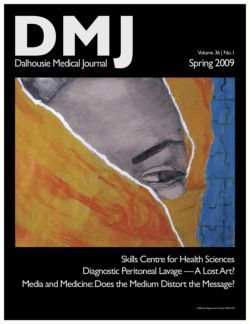Diagnostic Peritoneal Lavage – A Lost Art? A Retrospective Observational Study at a Canadian Tertiary Trauma Centre
DOI:
https://doi.org/10.15273/dmj.Vol36No1.3870Abstract
INTRODUCTION: Abdominal trauma is a leading cause of morbidity and mortality in the young, adult patient in North America. The standard tools to assess the severity of abdominal trauma have been evolving. The continuing role of diagnostic peritoneal lavage (DPL) as a clinical tool to evaluate intra-abdominal injury today remains controversial. This study investigated trends in the use of DPL, CT (computerized tomography) and FAST (Focused Assessment with Sonography for Trauma) in trauma patients in the province of Nova Scotia‘ssingle adult tertiary trauma centre.
METHODS: We conducted a retrospective analysis of all patients over the age of 15 with severe blunt and/or penetrating abdominal trauma from 1996 to 2001 who presented to a tertiary care hospital in Nova Scotia. Patients included in this study were those with an injury severity score (ISS) of ’‰¥9 for penetrating trauma and ’‰¥12 for blunt trauma and were derived from the Nova Scotia Trauma Registry. Descriptive statistics were utilized to determine trends over the six year period.
RESULTS: Of 172 patients included in the final cohort, the majority were male and under the age of 50. Blunt abdominal injury was far more common than penetrating abdominal injury in this cohort. Abdominal CT, FAST, and DPL were performed in 43.6%, 19.8% and 0.6% of the patients respectively. Absolute numbers of CTs and ultrasounds performed for abdominal trauma increased; however, the percentage of patients receiving those investigations remained constant.
DISCUSSION: Despite having excellent published test characteristics and extensive literature supporting its use, DPL is not commonly used today to assess blunt/penetrating abdominal injury in major trauma patients in Nova Scotia‘s tertiary trauma centre. These trends may have implications for guideline formulation for care of the major trauma patient with suspected intra-abdominal injuries.
Downloads
Published
2009-06-12
How to Cite
Di Quinzio, M. L., Petrie, D. A., & Tallon, J. M. (2009). Diagnostic Peritoneal Lavage – A Lost Art? A Retrospective Observational Study at a Canadian Tertiary Trauma Centre. DALHOUSIE MEDICAL JOURNAL, 36(1). https://doi.org/10.15273/dmj.Vol36No1.3870
Issue
Section
Research
License
Authors who publish with this journal agree to the following terms:
- Authors retain copyright and grant the journal right of first publication with the work simultaneously licensed under a Creative Commons Attribution License that allows others to share the work with an acknowledgement of the work's authorship and initial publication in this journal.
- Authors are able to enter into separate, additional contractual arrangements for the non-exclusive distribution of the journal's published version of the work (e.g., post it to an institutional repository or publish it in a book), with an acknowledgement of its initial publication in this journal.
- Authors are permitted and encouraged to post their work online (e.g., in institutional repositories or on their website) prior to and during the submission process, as it can lead to productive exchanges, as well as earlier and greater citation of published work (See The Effect of Open Access).


